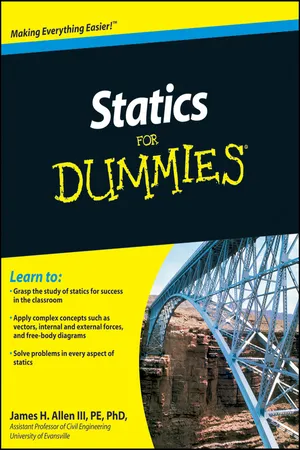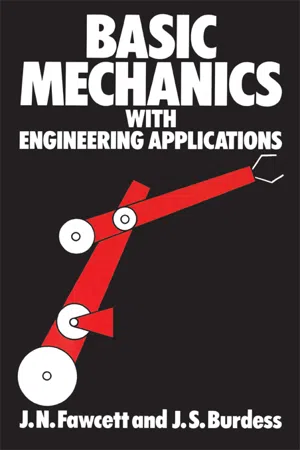Physics
Displacement Vector
A displacement vector in physics represents the change in position of an object from its initial to final location. It has both magnitude and direction, and is typically represented by an arrow. The length of the arrow corresponds to the magnitude of the displacement, while the direction of the arrow indicates the direction of the displacement.
Written by Perlego with AI-assistance
Related key terms
Related key terms
1 of 4
Related key terms
1 of 3
8 Key excerpts on "Displacement Vector"
- David V. Guerra(Author)
- 2023(Publication Date)
- CRC Press(Publisher)
Kinematics, first developed by Galileo, is the formal study of the motion of objects using diagrams, graphs, and equations. In the previous chapters, the analysis employed assumed the objects were either at rest or moving at a constant speed. Situations under these conditions are known as a static, because the forces are balanced. When the forces become unbalanced, accelerated motion results. In this chapter, the terminology used to describe all types of motion is formalized in preparation for subsequent chapters in which the resulting motion of unbalanced force will be studied. This chapter will start with a definition of displacement and then explore velocity and acceleration in both graphical and analytical formats. It is important to realize that the problem-solving techniques employed in this chapter are different than those used in the previous and subsequent chapters, and this is only a brief aside to introduce the terminology and practices of kinematics.- Displacement: The displacement (of an object is the change in position of an object relative to a fixed origin, as described in Figure 7.2 .d ⇀)FIGURE 7.2 Definition of displacement.Displacement is a vector. Suppose that at time t0 , a particle is at position(relative to the origin of an x-y coordinate system), and at time t1 , the particle is at positionr ⇀0The displacement that the particle undergoes from time t0 to time t1 is then given in equation (7.1) as:.r ⇀1The SI unit for the magnitude of the Displacement Vector is the meter (m).(7.1)=d ⇀01−r ⇀1r ⇀0As an example of a displacement, as depicted in Figure 7.3 , at time t0 a man is 5 m east of a lamppost and is walking directly away from the lamppost so that he is 15 m east of the lamppost at time t1 . His displacementfrom time t0 to time t1 would be 10 m eastward.d ⇀01FIGURE 7.3 Displacement example.
- Velocity: In previous chapters, the velocity (of an object was defined as the speed of the object and the direction in which the object is moving. This definition is more precisely known of the instantaneous velocity of an object, to distinguish it from the average velocity over a known time interval. The average value-with-direction of the velocityv ⇀)v ⇀over some time interval, from time t0 to time t1 , is shown in equation (7.2) and obtained by dividing the total displacementthat occurs during that time interval by the duration of the time interval t01 = t1 − t0 :d ⇀01The SI unit for velocity is the meter per second (m/s).(7.2)=v ⇀Avg01 s / d ⇀01t 01For example, if the man in the previous example, shown in Figure 7.3
- No longer available |Learn more
- Robert A. Pelcovits, Joshua Farkas(Authors)
- 2023(Publication Date)
- Barrons Educational Services(Publisher)
2.Earlier, we saw that displacement is a vector (such that if an object starts and ends of the same position, positive and negative displacements sum to zero). In contrast, total distance can never be negative and can be zero only if the object does not move at all.Definition of displacementTherefore, the Displacement Vector points from the object’s initial position to its final position. As in one dimension, displacement is independent of the path taken between the initial and final points (whereas total distance is path dependent). As before, displacement ≤ total distance.3.The average velocity during a given time interval is parallel to the Displacement Vector, as can be seen from the following equation (recall that multiplying a vector by a positive scalar produces a parallel vector).4.The direction, magnitude, and significance of the acceleration vector will be discussed later in this chapter.Problem Solving: Two Dimensions
Because two-dimensional vector equations reduce to independent one-dimensional equations, the different components of motion are entirely independent of each other (other than being time synchronized). Therefore, kinematics problems in two dimensions can be solved by applying one-dimensional kinematics equations to each particular dimension and coordinating the motion by using a single time parameter.TIP Two-dimensional kinematics problems are solved by treating each dimension using the one dimensional methods shown earlier.Sally is chasing Calvin. Calvin is moving along a path defined by the position vector Sally is moving along the path (a)Will Sally catch Calvin? (b)If so, what will the angle between their two velocities be at the time of impact?Example 2.8 A Two-dimensional Collision ProblemSolution(a)For two point objects to collide, they must have equal x- and y-components at a particular instant of time. Mathematically speaking, we write down the simultaneous equations x(t)Calvin = x(t)Sally and y(t)Calvin = y(t)Sally and see if there are any solutions to these two equations with a common value of t - eBook - ePub
- Hiqmet Kamberaj(Author)
- 2021(Publication Date)
- De Gruyter(Publisher)
4 Two- and three-dimensional motionIn this chapter, we will discuss the kinematics of a particle moving in two and three dimensions. Utilizing two- and three-dimensional motion, we will be able to examine a variety of movements, starting with the motion of satellites in orbit to the flow of electrons in a uniform electric field. We will begin studying in more detail the vector nature of displacement, velocity, and acceleration. Similar to one-dimensional motion, we will also derive the kinematic equations for three-dimensional motion from these three quantities’ fundamental definitions. Then the projectile motion and uniform circular motion will be described in detail as particular cases of the movements in two dimensions.4.1 The displacement, velocity, and acceleration vectors
When we discussed the one-dimensional motion (see Chapter 3 ), we mentioned that the movement of an object along a straight line is thoroughly described in terms of its position as a function of time,x ( t ). For the two-dimensional motion, we will extend this idea to the movement in thex yplane.As a start, we describe a particle’s position by the position vector r pointing from the origin of some coordinate system to the particle located in thex yplane, as shown in Fig. 4.1 . At timet ithe particle is at point P, and at some later timet fit is at the position Q. The path from P to Q generally is not a straight line. As the particle moves from P to Q in the time intervalΔ t =, its position vector changes fromt f−t ir itor f.Definition 4.1 (Displacement Vector).
The displacement is a vector, and the displacement of the particle is the difference between its final position and its initial position. We now formally define the Displacement Vector for the particle as the difference between its final position vector and its initial position vector:(4.1)Δ r =r f−r i.The direction ofΔ ris indicated in Fig. 4.1 from P to Q. Note that the magnitude ofΔ r - eBook - ePub
- James H. Allen(Author)
- 2010(Publication Date)
- For Dummies(Publisher)
Defining a VectorThis chapter focuses on exploring the behavior of vectors, seeing the commonalities in their construction, and understanding some of the subtle differences in their creation and application. In this chapter, I define the three major pieces of information you use to help a vector properly describe an action, I show you a few ways to draw a vector, and I break down the three primary types of vectors. This chapter won’t have you building a bridge immediately, but it does help you take your first step in getting a handle on the world around you in proper statics style.You quickly discover that the ability to create and define a proper vector is an invaluable set of skills. This ability lends itself fluidly to solving statics problems. However, before you can become truly proficient in statics, you first need to understand some basic terminology and the three pieces of information you need to properly define a vector.Simply put, a vectoris a quantity that helps describe the way that an action is applied to an object or group of objects. For example, a velocity vector can describe the velocity motion of a golf ball after it has been hit by a nine-iron, and a distance vector can help depict how far away and in what direction it landed. A force vector can describe how hard and in what direction the golf club strikes the golf ball.Understanding the difference between scalars and vectorsMany different types of vectors exist — from velocity and Displacement Vectors, to vectors that describe magnetic field behavior, to vectors that are mathematical solutions of differential equations. In statics, the force vector is the main type of vector you have to deal with. (Note: Don’t confuse these types of vectors with the categories of vectors I describe later in the chapter.)Before you can dive very far into the heart of your study in statics, you need to understand the difference between a vector and a scalar , two terms that are always popping up in statics textbooks and practice:Scalar: A scalar quantity (or simply a scalar ) is any measurement made only with regard to an action’s amount (its magnitude) and not its direction. Examples of scalar quantities include the cost of this book, the temperature of the room around you, or the airspeed of Monty Python’s unladen swallow. You can describe all these quantities as a single amount - eBook - ePub
Doing Physics with Scientific Notebook
A Problem Solving Approach
- Joseph Gallant(Author)
- 2012(Publication Date)
- Wiley(Publisher)
Chapter 3Vectors
In the previous chapter, we described 1-dimensional motion. We specified an object’s position along one axis as either positive or negative. All information about the direction was carried by the sign.The universe is not 1-dimensional. There are more complicated motions that require more complicated descriptions. Fortunately, there are mathematical tools called vectors that will allow us to extend our study of motion to 2 and 3 dimensions. Vectors turn a difficult 2-d problem into two easy 1-d problems. That is a good trade.Many physical quantities can be described by a single number and a unit. Room temperature is approximately 21 °C and a typical class lasts about 3600 s. These numbers are called scalars. Temperature and time are examples of scalars. Scalars obey the usual rules of arithmetic. You can punch them into your calculator or use SNB. Scalars are old friends, the numbers you’ve been using for a long time. We just gave them a new name.Sometimes scalars are inadequate. Consider the following simple example. Suppose you walk 5 m, stop, then walk another 12 m. How far from your original location are you? It depends on the direction! Where you end up depends on both how far and in which direction you walk.If you only walk in one direction, you end up 5 m + 12 m = 17 m away from your initial position. If you walk 5 m to the left and then turn around and walk 12 m to the right, you end up 12 m - 5 m = 7 m to the right of your initial position. If you walk forward 5 m, turn right and walk another 12 m, you end up 13 m away from your initial position.Such quantities are called vectors. Vectors are mathematical quantities that have magnitude and direction. The vector’s magnitude tells us how much of the physical quantity we have. As Figure 3.1 - eBook - ePub
- Bill Cox(Author)
- 2001(Publication Date)
- Butterworth-Heinemann(Publisher)
Both of these representations are used at the elementary level, but the connection between them is not always easy to see. The situation is not helped by the fact that the terms ‘scalar’ and ‘vector’ are also used in matrix theory, and indeed matrices can be used to represent vectors – a 3 × 1 column matrix can be used to represent a vector for example. Again, the connections between these ideas are not always clear. However, we will usually use the representation of vectors by arrays, which is relatively straightforward to operate.In this book we will usually denote vectors by bold lower case – in written work it is usual to denote them by under line (a ) or over line (ā). To denote specific vector displacements from points A to B we use the notationNote that vectors have units of course, depending on the physical quantity they represent.AB →orAB ¯Whichever representation of vectors we use, we will eventually need a three dimensional coordinate system – simply so that we can state such things as length and direction unequivocally. There are a number of such coordinate systems in common use but we will use the simplest and most popular one – the generalisation of rectangular Cartesian coordinates .Exercise on 11.1 Classify the following as scalar or vector quantities:(i) area(ii) gravitational force(iii) electric field at a point(iv) density(v) potential energy(vi) work(vii) magnetic field(viii) time(ix) pressure(x) acceleration(xi) voltage(xii) momentumAnswers (i), (iv), (v), (vi), (viii), (xi) are all scalars. The rest are all vectors.11.2 Vectors as arrows
This is the most common approach to vectors at the elementary level. We treat the line segment representing a vector a as an abstract geometrical ‘free’ object. If a is specifically fixed to an origin, then it is referred to as a position vector – its tip designating the position of the point at the tip. Pictorially, we might display vectors as in Figure 11.1 .Figure 11.1 Free vectors as arrows.Note that the vector – a is simply a in the opposite sense.An algebra of such objects can be constructed which reflects geometrically the way in which vector quantities combine. Naturally, two vectors are equal if and only if they have the same magnitude and direction. The zero vector has zero magnitude and undefined direction – it is denoted 0 - eBook - ePub
- J Jones, J Burdess, J Fawcett(Authors)
- 2012(Publication Date)
- Routledge(Publisher)
OY axis is superfluous.Position and displacementThe position of a point at P may be described by its distance x along the line OX, as shown in Fig. 1.7 . In this case the position vector of the point is r = x. If the point now moves to P' such that its new position vector is x + δx, the change in position δx is called the displacement of the point.FIG . 1.7The number of degrees of freedom of a point is always equal to the number of independent co-ordinates needed to specify its displacement. In this case the displacement can be expressed in terms of a change in the single coordinate x, so that a point moving on a straight line has one degree of freedom. Since the direction of the Displacement Vector is specified by the straight line, all vectors must lie along OX. Hence when adding these vectors, the vector triangle of Fig. 1.3 will reduce to a straight line. This is equivalent to simple scalar addition, taking account of sign.The recommended SI units for position and displacement are metres, m, or millimetres, mm.VelocityConsider the point P with position x at time t. Let the point be moving such that a small time δt later it has moved to a new position x + δx. The displacement δx is the change in position, and is assumed to be positive in the same sense as x, i.e. along OX. The velocity ν of the point is defined as its rate of change of position and is given byThis limit defines the velocity of the point at position x. The derivative dx/dt is often written as , where the dot denotes differentiation with respect to time.Velocity, like position, is a vector quantity and in the case of straight line motion its direction is defined by its sign, which is the same as that of the incremental displacement δx. The recommended SI unit of time is the second, s, so that the SI unit of velocity will be m s−1 - eBook - ePub
- Tai-Ran Hsu(Author)
- 2018(Publication Date)
- Wiley(Publisher)
direction. Examples of vectorial quantities include the velocity of an object traveling either in a (2D) plane or in a (3D) space. As well as the example of the velocity of a moving vehicle, the concept includes related quantities such as acceleration. The force acting on an object is another vectorial quantity that has to be defined in terms of its magnitude and the direction in which the force is acting. Other vectorial quantities include the electric field, current flow, and heat transmission in solids and fluids.In contrast to vectorial quantities, common physical quantities in engineering analysis such as the temperature, speed, mass of an object, heat and energy, and electric potential are scalar quantities.A vector may be represented as a directed line segment as shown in Figure 3.1 . We will use boldfaced letters and notation to designate the vector quantities throughout this book.Graphical representation of a vector.Figure 3.1In Figure 3.1 the vector A is characterized by its magnitude |A| and its direction indicated with an arrowhead. Graphical representation of this vector includes an “initial point” shown as a solid circle at one end and a “terminal point” indicated by the arrowhead. A vector with the same magnitude of vector A but acting in the opposite direction carries a negative sign (i.e., ) as also shown in Figure 3.1 .Vector quantities are usually defined by a coordinate system in engineering analyses, for example in an x–y coordinate system as shown in Figure 3.2 .Rectangular x–y coordinate system for a vector. (a) Vector A in x–y coordinates. (b) Decomposition of vector AFigure 3.2
Index pages curate the most relevant extracts from our library of academic textbooks. They’ve been created using an in-house natural language model (NLM), each adding context and meaning to key research topics.
Explore more topic indexes
Explore more topic indexes
1 of 6
Explore more topic indexes
1 of 4







